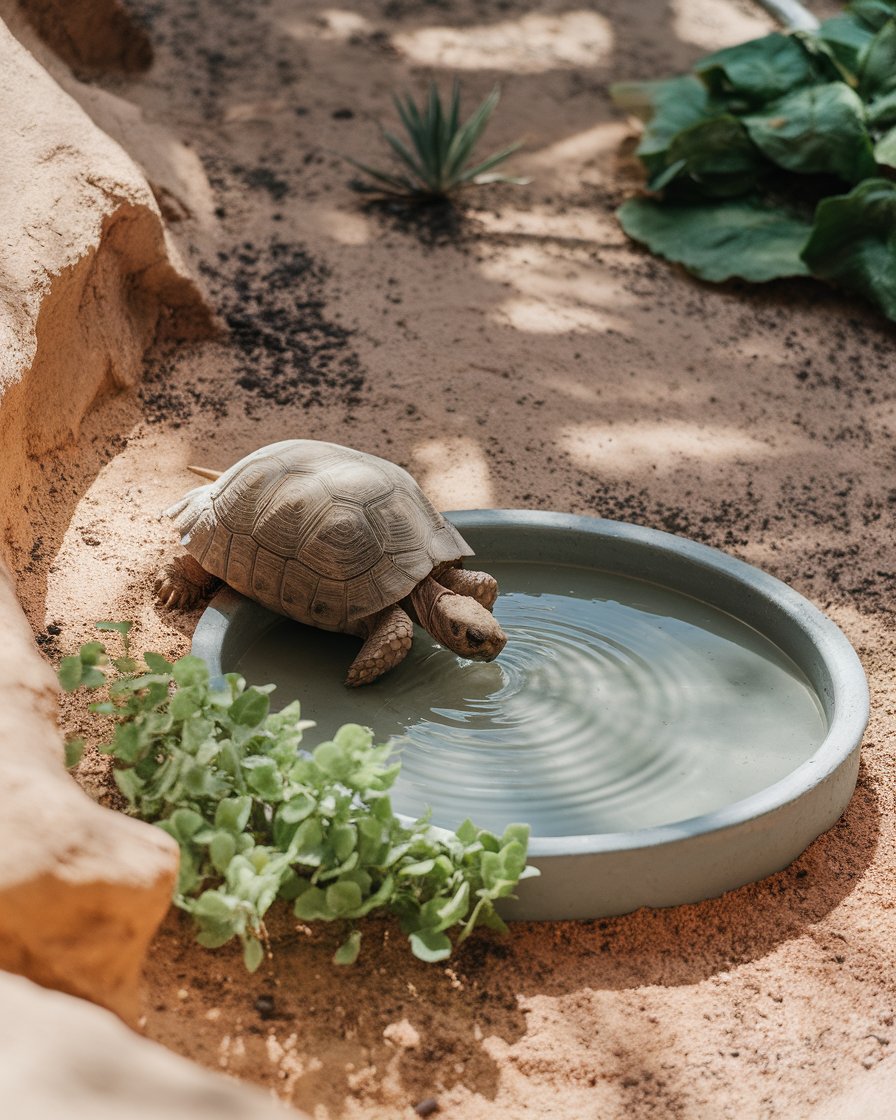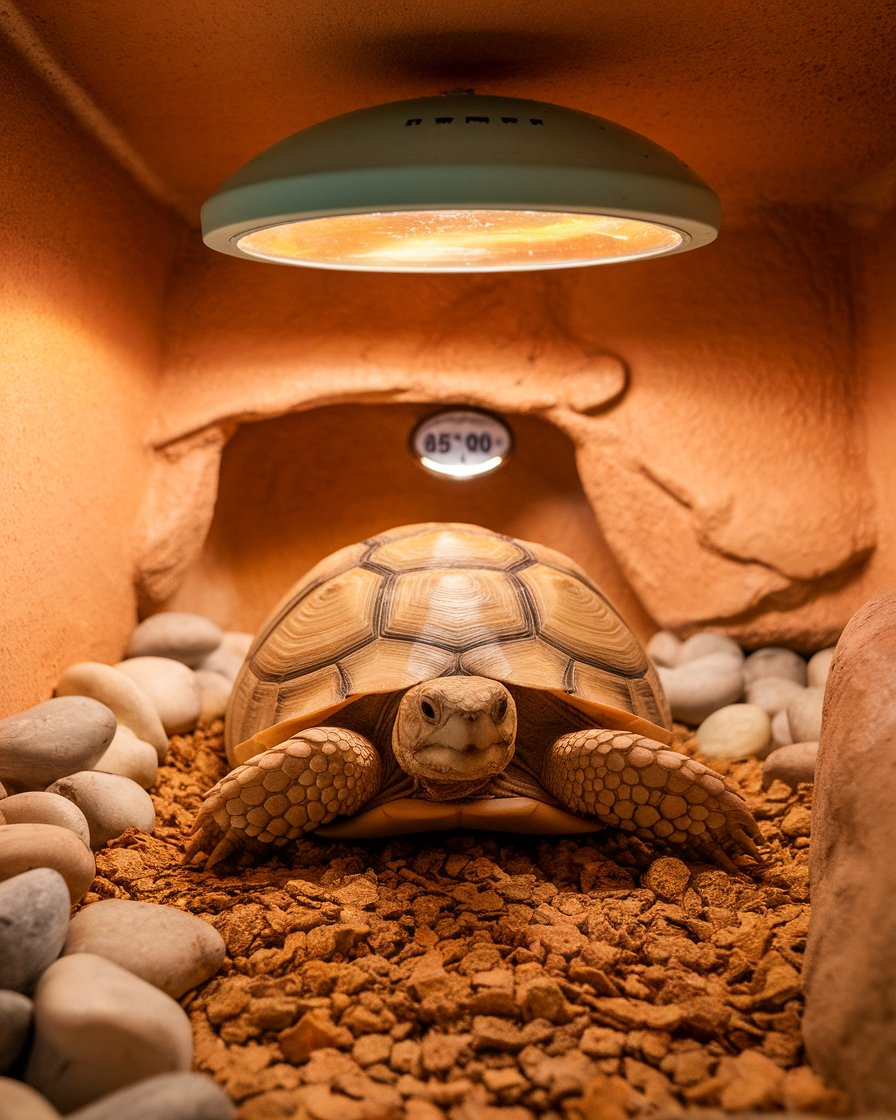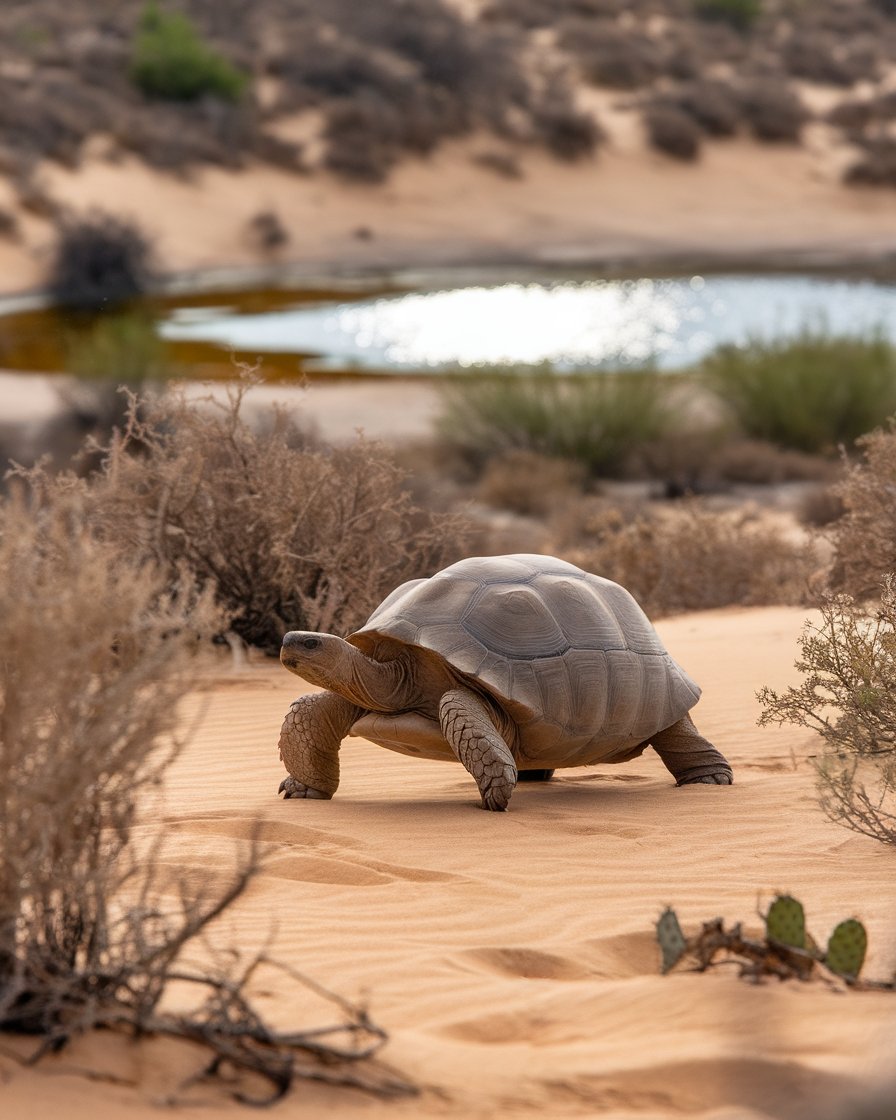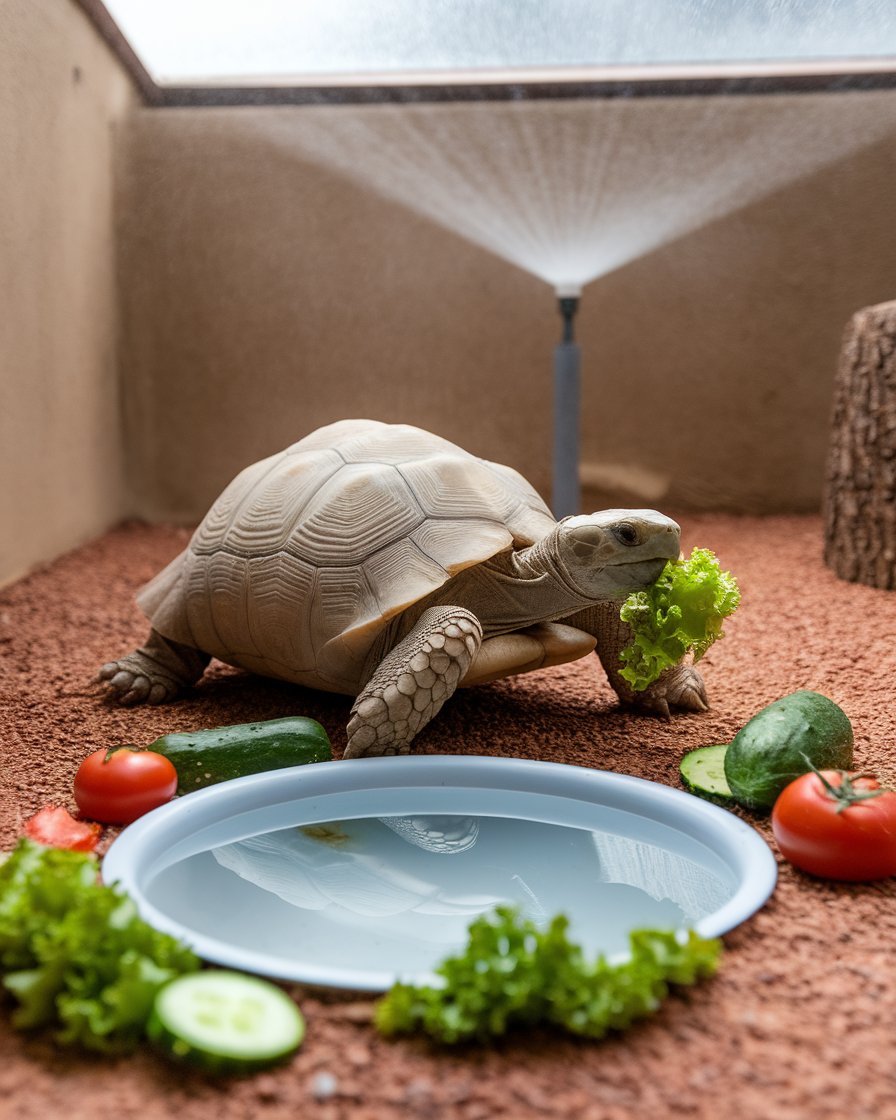- Equine Healing Aid and Skin Repair
- Clean Wounds
- Relieve Itchy Skin
- 16 ounces
Introduction
Ensuring proper hydration for desert tortoises is essential for their survival and health, especially considering their natural habitat in arid environments. These reptiles are well-adapted to low-water conditions, often relying on moisture from the plants they eat rather than directly drinking water. Owners of desert tortoises should focus on providing clean water in a shallow dish that allows them to drink and soak, aiding in their water absorption. Additionally, maintaining humidity levels in the tortoise’s enclosure helps them stay hydrated, especially for species that dig into the soil to retain moisture.
Tortoises drink water less frequently than other animals, but ensuring they have consistent access to water is critical. Offering water-rich fruits and vegetables such as cucumbers can enhance hydration. For new tortoise owners, joining reputable tortoise clubs can provide guidance on hydration methods and general care. Learning from seasoned tortoise enthusiasts can help you offer a better experience for your pet, ensuring they stay healthy and hydrated.
Key Takeaways
- Providing proper hydration for desert tortoises is critical due to their natural adaptation to arid environments with limited water sources.
- Using methods like a garden hose to create small puddles in their enclosure can encourage tortoises to drink water naturally.
- Feeding tortoises vegetables with high water content, such as cucumbers and leafy greens, can supplement their hydration needs.
- Careful monitoring is required when a tortoise gets wet, as prolonged exposure to moisture can lead to health issues like respiratory infections.
- Ensuring tortoises have a warm basking spot after exposure to moisture helps them dry off and maintain proper body temperature.
- Joining reputable tortoise clubs can offer valuable guidance on maintaining hydration and overall care from experienced tortoise owners.
Providing Water Sources for Desert Tortoises

Ensuring proper hydration for desert tortoises is critical to their health, as they naturally inhabit arid environments with limited water availability. Providing accessible water sources in their enclosure can help maintain their hydration levels, which in turn supports their overall well-being. Desert tortoises require fresh water daily, and it’s important to consider methods that encourage them to drink water regularly. Whether through direct water sources or alternative hydration methods like water-rich vegetables, keeping them well-hydrated is essential to prevent dehydration. Regular monitoring of their water intake is necessary to ensure their health, and it’s recommended that water is provided both indoors and outdoors, depending on where the tortoise is kept.
Effective Hydration Strategies for Desert Tortoises
1. Providing Daily Access to Fresh Water Desert tortoises, despite living in arid environments, require daily access to fresh water. Placing a shallow water dish in their enclosure is essential. This helps ensure that your tortoise can drink water and soak to retain hydration. Regularly cleaning and refilling the dish prevents contamination and supports their overall health.
2. Mimicking Natural Rainwater Collection To encourage desert tortoises to drink water, creating small puddles using a garden hose can be highly effective. This method imitates natural rainwater, which tortoises are naturally drawn to. Running the hose for a short period twice a week will allow them to drink and soak as they explore their habitat.
3. Including Water-Rich Vegetables in Their Diet Feeding your tortoise water-rich vegetables such as cucumbers, tomatoes, and leafy greens can supplement their hydration needs. These vegetables provide essential moisture while supporting their diet with nutrients, helping to ensure a well-balanced hydration routine.
Using Trick with Hose to Encourage Drinking
A clever technique to ensure your desert tortoise stays hydrated is using a garden hose to create small puddles in their enclosure. This method mimics natural rainwater collection, encouraging the tortoise to drink water as they explore the substrate. As desert tortoises are naturally drawn to small water sources, this strategy can be very effective. The puddles allow them to retain water more efficiently, and running the hose twice a week is often sufficient. Be mindful of not over-saturating the area, as standing water may lead to mold. However, when done correctly, it’s a simple yet effective method to support their hydration needs.
Using Vegetables with High Water Content for Hydration
Another practical way to promote hydration in desert tortoises is by feeding them vegetables with high water content. Cucumbers, tomatoes, and leafy greens such as lettuce are great examples. These water-rich foods not only help the tortoise absorb moisture but also provide essential nutrients. For species of tortoise like the sulcata or Russian tortoise, maintaining hydration through a well-balanced diet is key. Offering these foods at least twice a week can ensure they stay well hydrated, especially during the warmer months. Remember to monitor their water intake regularly, particularly if they are indoors, where humidity may be lower.
Caring for a Wet Desert Tortoise

Caring for a wet desert tortoise requires careful attention since these creatures are naturally adapted to dry, arid environments. Excessive moisture can cause stress and lead to respiratory issues or infections, which can severely impact their health. It’s important to avoid letting the tortoise stay wet for prolonged periods, especially in cooler temperatures. While soaking them occasionally can aid in hydration and cleaning, it’s crucial to provide a proper drying and warming environment afterward. Owners should monitor their tortoises closely during wet conditions to ensure they don’t experience stress or discomfort, which could be harmful to their overall well-being.
Case Study: Managing a Wet Desert Tortoise After a Rainstorm
In a case reported by a desert tortoise rescue organization in Nevada, a wild desert tortoise was found wandering after a rare rainstorm. The tortoise was wet and appeared stressed, as desert tortoises are not adapted to prolonged exposure to moisture. The rescue team immediately placed the tortoise in a warm, dry environment, with temperatures maintained between 85°F and 90°F using a heat lamp. This allowed the tortoise to dry off and regulate its body temperature, preventing respiratory complications. Over the next few hours, the team closely monitored the tortoise for signs of respiratory issues, such as labored breathing or lethargy.
By ensuring the tortoise had proper warmth and a dry environment, they successfully avoided any long-term health complications. This case highlights the importance of creating a controlled environment for wet tortoises to dry off, demonstrating that even brief exposure to moisture can be managed with the right care techniques.
Caution When Tortoise Gets Wet
When your desert tortoise becomes wet, particularly after a soak or during cleaning, it’s essential to be cautious. These tortoises are not designed to stay in moist environments for extended periods. After a soak, ensure they’re not exposed to drafts or cooler temperatures, which could weaken their immune system or lead to breathing issues. Keep an eye on their behavior to detect any signs of distress, such as lethargy or labored breathing. Ensuring their shell and body dry quickly can prevent unwanted health problems. Regularly monitoring these signs helps avoid complications and promotes a healthy, stress-free environment for your tortoise.
Ensuring Warmth During Wet Conditions
After your desert tortoise has been exposed to moisture, providing a warm, dry space is crucial. Tortoises need to bask in temperatures between 85°F and 90°F to regulate their body temperature and dry off efficiently. Without proper warmth, wet tortoises can struggle to maintain their health, which can result in respiratory infections or shell issues. Create a designated basking spot with a heat lamp to help them recover from any exposure to water. Additionally, ensure their enclosure retains proper humidity without becoming overly moist, as excessive dampness can lead to mold or other harmful conditions for the tortoise.
Behavior of Desert Tortoises and Water

Desert tortoises have unique adaptations when it comes to water consumption. Living in arid regions, they can survive long periods, sometimes up to a year, without direct water sources. Their primary hydration comes from the plants they eat, which provide the necessary moisture to sustain them. During cooler months like spring and autumn, desert tortoises are more active and will search for water sources. This behavior allows them to endure extreme desert conditions by conserving water and relying on their environment. It’s important for owners to replicate this natural habitat and understand the tortoise’s minimal water needs while ensuring proper hydration techniques.
Reasons for Limited Water Consumption in Tortoises
Desert tortoises have evolved to consume very little water due to their harsh, dry environments. Most of their water intake comes from the moisture in the plants they eat, such as grasses and leafy vegetation. They also have the ability to retain water in their bodies for extended periods, allowing them to go without fresh water for months at a time. This adaptation is essential for survival in the wild, where water sources are often scarce. Owners should understand that desert tortoises may not always drink from a water dish regularly, but providing one is still crucial in case they need additional hydration.
Addressing Hydration Concerns in Tortoises
To ensure your desert tortoise stays hydrated, it’s important to provide a shallow water dish for drinking and soaking. Place the dish in a shaded area of their enclosure to prevent the water from getting too hot. Regularly check the water level and cleanliness, as dirty water can lead to health issues. Soaking your tortoise in warm water for 10-15 minutes weekly is also a good practice, as it helps with hydration and digestion. If you notice any signs of dehydration, such as sunken eyes or lethargy, consult a vet for recommendations. Maintaining proper hydration is key to keeping your tortoise healthy and happy.
“Water is the driving force of all nature.” – Leonardo da Vinci
Long-Term Hydration Strategies for Desert Tortoises

Maintaining long-term hydration for desert tortoises is crucial for their health, as they naturally inhabit dry, arid environments where water is scarce. Owners must provide consistent access to water, while also mimicking the tortoise’s natural environment to support hydration. Offering a shallow water bowl for drinking and soaking is essential, as desert tortoises will occasionally need to rehydrate. Additionally, ensuring the enclosure retains some humidity, especially for species that dig, can help them absorb moisture through the substrate. These strategies, along with regular monitoring of their hydration levels, will help keep tortoises healthy for the long term.
Joining Reputable Tortoise Clubs for Guidance
Desert tortoise owners can gain a wealth of knowledge by joining reputable tortoise clubs. These organizations bring together experienced caretakers and new owners alike, offering a space to discuss hydration strategies and general tortoise care. Members share valuable insights, such as tips on using water bowls or rehydration baths, that can be incredibly helpful. Additionally, club resources often include advice from experts who have studied various species and their hydration needs. Joining a club provides not only guidance but also a sense of community, helping owners feel supported while caring for their tortoises’ long-term health.
Utilizing Experience from Old Timers in Tortoise Care
Learning from seasoned tortoise caretakers, often called “old timers,” is a great way to improve your hydration practices for desert tortoises. These individuals have likely spent years caring for various tortoise species, including those that require specific hydration routines. Their experience with keeping tortoises well-hydrated in different climates, using techniques like spraying enclosures to retain humidity or offering the right water bowls, can be invaluable. By adopting tried-and-tested methods from these caretakers, new owners can ensure their tortoises stay hydrated while avoiding common mistakes, ultimately fostering a healthier, more comfortable environment for their pets.
Conclusion
Ensuring the proper hydration of your desert tortoise is key to their long-term health and survival, especially in captivity. With their natural adaptation to arid environments, these reptiles require careful attention when it comes to water availability. Providing a shallow water dish for your tortoise to drink from and soak in can significantly improve their hydration. In addition, offering water-rich vegetables and maintaining proper humidity in their enclosure, especially for species like the baby Greek tortoise, ensures they remain healthy and comfortable.
It’s equally important to monitor your tortoise’s water intake and behavior closely, particularly during wet or humid conditions. Excess moisture can lead to health problems, including respiratory issues. For this reason, providing a warm and dry shelter is crucial, especially after exposure to water. By learning from experienced caretakers and reputable sources, you can adopt strategies that keep your tortoise well-hydrated, ensuring their enclosure offers the right environment—whether indoor or outdoor.

James Dunnington leads the James Dunnington Collection, featuring five unique blogs: a practical Pet Care Guide, an enlightening Ancient History Blog, a resourceful Home Improvement Guide, a cutting-edge Tech Innovation Guide, and a strategic Online Money Making platform. Each site delivers valuable insights designed to empower and inform. For updates and more tips, visit our Contact Us page to sign up for our newsletter, ensuring you never miss out on the latest content from any of these dynamic fields.
